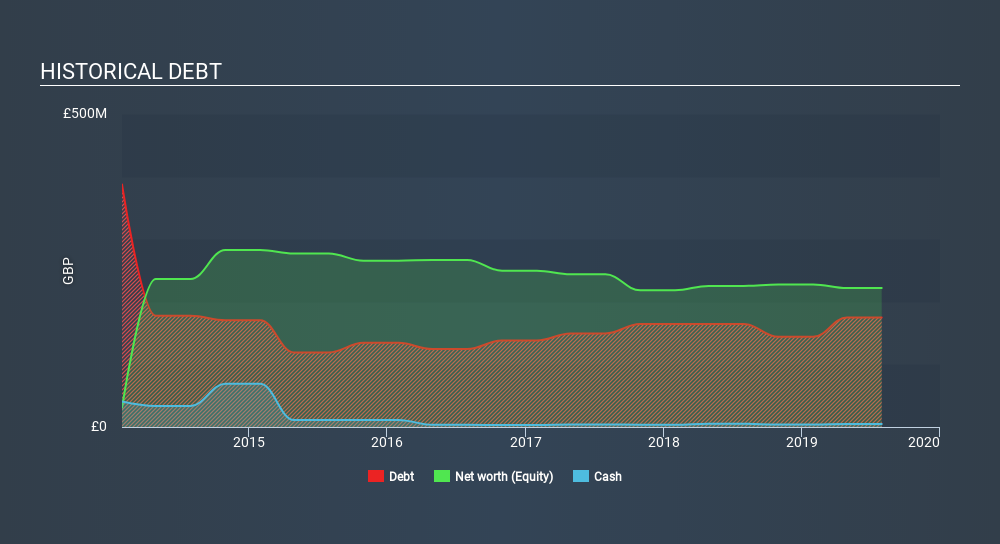The external fund manager backed by Berkshire Hathaway’s Charlie Munger, Li Lu, makes no bones about it when he says ‘The biggest investment risk is not the volatility of prices, but whether you will suffer a permanent loss of capital. It’s only natural to consider a company’s balance sheet when you examine how risky it is, since debt is often involved when a business collapses. Importantly, Card Factory plc (LON:CARD) does carry debt. But the real question is whether this debt is making the company risky.
Why Does Debt Bring Risk?
Debt and other liabilities become risky for a business when it cannot easily fulfill those obligations, either with free cash flow or by raising capital at an attractive price. Part and parcel of capitalism is the process of ‘creative destruction’ where failed businesses are mercilessly liquidated by their bankers. However, a more usual (but still expensive) situation is where a company must dilute shareholders at a cheap share price simply to get debt under control. By replacing dilution, though, debt can be an extremely good tool for businesses that need capital to invest in growth at high rates of return. When we examine debt levels, we first consider both cash and debt levels, together.
View our latest analysis for Card Factory
How Much Debt Does Card Factory Carry?
As you can see below, at the end of July 2019, Card Factory had UK£174.8m of debt, up from UK£164.7m a year ago. Click the image for more detail. However, it does have UK£4.80m in cash offsetting this, leading to net debt of about UK£170.0m.

How Strong Is Card Factory’s Balance Sheet?
According to the last reported balance sheet, Card Factory had liabilities of UK£99.0m due within 12 months, and liabilities of UK£282.1m due beyond 12 months. Offsetting these obligations, it had cash of UK£4.80m as well as receivables valued at UK£19.4m due within 12 months. So it has liabilities totalling UK£356.9m more than its cash and near-term receivables, combined.
Given this deficit is actually higher than the company’s market capitalization of UK£296.8m, we think shareholders really should watch Card Factory’s debt levels, like a parent watching their child ride a bike for the first time. Hypothetically, extremely heavy dilution would be required if the company were forced to pay down its liabilities by raising capital at the current share price.
We measure a company’s debt load relative to its earnings power by looking at its net debt divided by its earnings before interest, tax, depreciation, and amortization (EBITDA) and by calculating how easily its earnings before interest and tax (EBIT) cover its interest expense (interest cover). This way, we consider both the absolute quantum of the debt, as well as the interest rates paid on it.
Card Factory’s net debt to EBITDA ratio of about 2.0 suggests only moderate use of debt. And its strong interest cover of 19.6 times, makes us even more comfortable. The bad news is that Card Factory saw its EBIT decline by 18% over the last year. If earnings continue to decline at that rate then handling the debt will be more difficult than taking three children under 5 to a fancy pants restaurant. The balance sheet is clearly the area to focus on when you are analysing debt. But it is future earnings, more than anything, that will determine Card Factory’s ability to maintain a healthy balance sheet going forward. So if you want to see what the professionals think, you might find this free report on analyst profit forecasts to be interesting.
Finally, a company can only pay off debt with cold hard cash, not accounting profits. So we clearly need to look at whether that EBIT is leading to corresponding free cash flow. During the last three years, Card Factory produced sturdy free cash flow equating to 80% of its EBIT, about what we’d expect. This cold hard cash means it can reduce its debt when it wants to.
Our View
We feel some trepidation about Card Factory’s difficulty EBIT growth rate, but we’ve got positives to focus on, too. For example, its interest cover and conversion of EBIT to free cash flow give us some confidence in its ability to manage its debt. Taking the abovementioned factors together we do think Card Factory’s debt poses some risks to the business. So while that leverage does boost returns on equity, we wouldn’t really want to see it increase from here. There’s no doubt that we learn most about debt from the balance sheet. But ultimately, every company can contain risks that exist outside of the balance sheet. For instance, we’ve identified 4 warning signs for Card Factory (1 is potentially serious) you should be aware of.
When all is said and done, sometimes its easier to focus on companies that don’t even need debt. Readers can access a list of growth stocks with zero net debt 100% free, right now.
If you spot an error that warrants correction, please contact the editor at [email protected]. This article by Simply Wall St is general in nature. It does not constitute a recommendation to buy or sell any stock, and does not take account of your objectives, or your financial situation. Simply Wall St has no position in the stocks mentioned.
We aim to bring you long-term focused research analysis driven by fundamental data. Note that our analysis may not factor in the latest price-sensitive company announcements or qualitative material. Thank you for reading.

